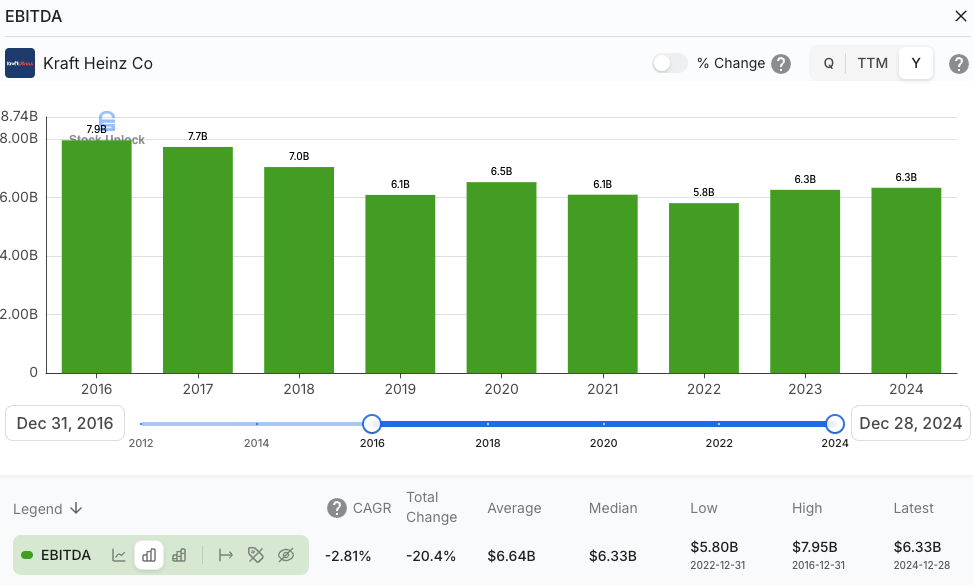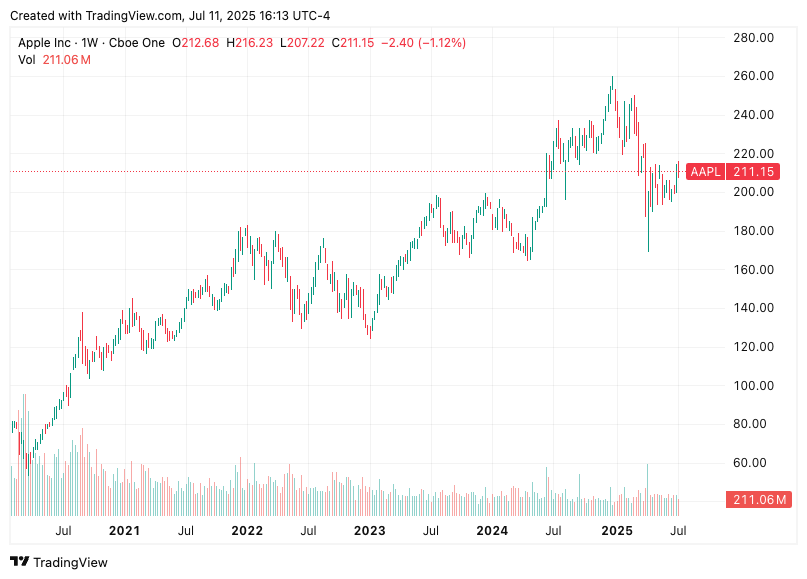Weekly #38: Kraft Heinz Breakup & Why Your Best Ideas Aren’t Yours
From Kraft Heinz’s Cost-Cutting Fallout to Borrowed Investing Ideas and Why We’re Up 10.2% YTD
Hello fellow Sharks,
This week, the market pulled back a bit compared to last week, and our overperformance to the S&P narrowed a bit. (If you want to skip ahead to the Portfolio Update, click here.)
I am reading The Order of Time by Carlo Rovelli. I don’t think I’ve made this many notes on a book in quite a while, as every sentence is thought-provoking. The book makes a strong argument that our understanding of time as linear, universal, and flowing is an illusion shaped by human perception, not a fundamental property of the universe.
I admit this is way over my head 🤯.
We all experience time, so it’s difficult for me to accept that time might just be an illusion rather than a fundamental property of the universe.
And while we’re on the topic of things that only exist because we all agree they do, remember my piece “Storytelling is a double-edged sword, so be careful.” Money and investing exist in the same realm of inter-subjective truth; they’re not inherent properties of the universe, but rather stories that humans choose to believe.
What kept me thinking about this for days is that time is one of the most crucial factors in investing.
Compounding works precisely because of time. If you’re still skeptical, I’ve written more about it here.
Depending on time, an investment could be bad, meh, or great.
If you bought AAPL in October 2018, you would have lost 35% of your investment if you sold in January 2019.
But if you decided not to sell at that time, and sold today, you would have gained +260%.
So what does this all mean?
Honestly, I don’t know, and this Weekly isn’t about trying to solve that mystery (though if you have an answer, I’m all ears!).
Instead, the thought of the week is about how ideas are rarely original. Carlo credits Julian Barbour as the first person to propose the idea that time is an illusion, which Julian discussed in his book The End of Time. Julian’s ideas were inspired by Ernst Mach, Albert Einstein, Wheeler, DeWitt, and I’m sure they had their own sources of inspiration as well. I’d even bet some of Einstein’s groundbreaking thoughts were sparked by the patent applications he reviewed.
So this week, I want to explore borrowing ideas in investing: what’s acceptable (and what’s not), and how to leverage this fundamentally human practice to its fullest potential.
Finally, also this week, I share my view on the Kraft Heinz breakup.
Enjoy the read!
~ George
Table of Contents:
In Case You Missed It
New addition to the portfolio
On Monday, July 7th, I sent a trade alert where I closed positions in two US fintechs and replaced them with one Asian bank. On Friday, I followed up with a deep dive into this new position. This bank boasts double-digit ROE, trades below book value, and pays dividends that are growing. Management has also been consistently repurchasing shares, and guided that repurchases will continue as long as the shares trade below book value.
This move not only trims some of our US exposure but also increases the global flavour of the portfolio.
My Two Cents on the Kraft Heinz Split
Usually, I do not drop this sort of deal commentary into the Weekly, but I am making an exception. I worked in corporate finance at Kraft Heinz (KHC 0.00%↑) and at its 3G Capital sister company AB InBev (BUD 0.00%↑), so I have to share my view. 😊
The Wall Street Journal issued a piece on KHC splitting up on Friday. I recommend you read it here.
I knew this breakup was imminent since my days at KHC. It was clear that 3G wanted to run the ketchup factory with the same playbook that worked for beer. They assumed the AB InBev formula (buy, slash costs with zero‑based budgeting, squeeze suppliers, then raise margins) could copy‑paste onto mac and cheese. They missed a huge point. Selling beer and selling ketchup (or mac and cheese) are completely different games when it comes to unit economics, supply chains, and customer behaviour.
A keg of Bud rides the three‑tier alcohol system, where wholesalers fight for exclusive territories and consumers show near‑tribal brand loyalty. Economies of scale shine there. A bottle of ketchup fights for shelf space inches away from cheaper private labels, with stores demanding promo money every quarter. Volume alone does not save you.
Management tried to force the cost diet anyway. In 2019, Kraft Heinz wrote down fifteen billion of brand value after the cuts hollowed out marketing and R&D. Bain1 and others2 have since shown that zero‑based budgeting rarely boosts growth in consumer brands and often wrecks morale.
Look at the results of the merger.
#1 revenues have been flat since the merger 10 years ago.

#2 EBITDA actually has declined since the merger

and #3, the stock price is down 62%
Berkshire has already walked off the board, and 3G quietly sold its entire stake in 2023.
Why did it work for beer?
Beer is high margin, perishable once tapped and subject to heavy regulation that keeps disruptors out. The SABMiller deal still paid off even with bumps because AB InBev could lean on that moat. Grocery aisles offer no such shelter.
So here is my take.
If they split the units and a strategic operator can pick up the pieces. The pantry brands still throw cash, and the sauces unit still owns prime real estate on every condiment shelf, yet both are starved for real product innovation. Value will only emerge if the next owner starts reinvesting a decent slice of that cash in R&D. Think cleaner labels, less sugar, bolder global flavours, and credible plant‑based lines instead of gimmicks like the infamous pink Mac & Cheese Valentine’s stunt that tasted like melted candy hearts. It grabbed headlines and clogged my inbox with memes, but it never drove repeat sales.
I remember one leadership meeting where we spent two hours debating how to redeploy marketing dollars to "juice brand equity." A VP finally stood up and said he was shocked we had not spent a single minute talking about improving the food.
The room went silent…
That silence is the opportunity.
Shift the conversation from shifting ad spend to making meals people feel good about eating.
Operationally, the fix is simple. Create small cross‑functional squads that can tweak recipes in weeks, run live tests with loyal shoppers, and scale winners through the existing supply chain. Use the balance sheet to back real innovation, automate plants to cut waste, not headcount, and lock in sustainable packaging that shoppers already expect. With that playbook, each unit could shine once freed from a one‑size‑fits‑all cost vice.
I could rant for pages about the missteps, but you get the gist. In the meantime, I will watch who steps up to run the grocery spin and whether fresh capital finally funds growth instead of scissors.
Thought of the Week: Ideas Are Borrowed, Not Born in Isolation
Years ago, whenever someone else pitched my stock idea with my thesis, I’d bristle, thinking, “Hey, that was mine!”
I eventually realized it’s normal, in fact inevitable, that ideas float around.
As Mohnish Pabrai put it,
I’m a shameless copycat… I have no original ideas.
Even writers have noted this: Montaigne confessed to simply arranging “other men’s flowers” into a nosegay. Filmmaker Jim Jarmusch said, “Nothing is original… originality is nonexistent.”
Our minds remix what’s already out there.
Creative thinkers agree that all innovation is really just connecting the dots. I wrote about connecting the dots in investing, in case you are curious. All creativity ultimately boils down to existing ideas combining to form new ideas.
In other words, every “new” idea is a collage of things you’ve seen, read, or experienced. When I think of investing ideas, I realize mine came from mixing company reports, news tidbits, analysis from others (Morningstar, Seeking Alpha, Value Investing Club…) and past observations. This isn’t bad, it’s exactly how new insights happen. In fact, by standing on others’ shoulders, you can see farther.
Charlie Munger summed it up:
The best thing a human being can do is to help another human being know more.
In markets, that means sharing research and insights.
In investing, spreading your ideas widely can even help make them come true. If others buy into your thesis, the stock moves faster to its fair price. Good investors want people to learn about their ideas because broader awareness helps the market catch up.
I remember being frustrated at first when others echoed my stock picks point-for-point. Later, I realized it’s fine, in fact helpful, if smart people rally around a good thesis. We’re not thieves in a conspiracy; we’re collaborators in idea-sharing. As long as everyone does their homework, consensus is how prices reflect true value.
That said, don’t just take any idea at face value. If you read, “Company XYZ is the global leader in ABC,” don’t just nod. Always do your own research. Check the facts yourself: read the financials, compare competitors, and confirm market data. Consider who wrote it and why; is there bias or hype? Be sure the numbers actually back up catchy claims.
In practice, I have a list of tips I follow when vetting ideas:
Verify the core claim. If someone says “#1 in the world,” pull up the data and see what that really means. Look at market share, growth rates or user numbers.
Check multiple sources. Don’t rely on one article or analyst. See if independent filings or news reports agree.
Beware hype and hot takes. If it sounds like a pitch, dig deeper. Many writing platforms (Morningstar, Seeking Alpha, Yahoo Finance) offer valuable reports, but treat them as starting points, not gospel.
Think critically. Always ask why you’re buying. What can go wrong? A healthy dose of skepticism keeps your own take fresh.
Nurturing Your Own Ideas: Read and Stay Curious
To generate strong investment ideas, cultivate knowledge and curiosity.
Reading is #1.
Warren Buffett famously spends about 80% of his day reading and thinking. He “reads 500 pages” a week, saying knowledge compounding works like interest.
Broad reading, not just finance reports but technology, science, history, and even literature, fills your mental toolbox. Stories and books train your brain to think in narratives and analogies, unlocking creativity. Research by Ohio State University explains that stories and varied reading “activate anything your brain can do,” making you more imaginative.
In practice, I try to read a mix of annual reports, industry news, and general-interest books. Every page can spark a new connection. If you are still not buying it, I explained in an article Why Your Reading List Is More Important Than Your Watchlist.
Curiosity is equally critical.
Never stop asking how or why. Einstein said, “I have no special talents. I am only passionately curious.” He added, “The important thing is not to stop questioning”. That’s a mantra for idea creation. Wonder about the mundane: how does my microwave heat food in seconds, or how does a text message traverse the globe instantly? Questions like that might lead you to a semiconductor company’s chip innovations or a telecom play you’d never have considered.
In everyday life, noticing patterns (and the exceptions) is key. One tactic is to carry a notebook or use your phone’s notes: jot down interesting facts or questions on your commute, and later see if unrelated notes can spark something new.
Here are some ways I nurture ideas daily:
Read widely and constantly. Make it a habit to learn something new every day. I know it’s a cliché by now, but I truly believe it: if you’re not learning something new every day, you’re falling behind.
Ask “What if…?” When faced with a fact or statistic, play devil’s advocate. What if the opposite were true, or what if a small tweak changed things? Divergent questions often reveal hidden angles.
Observe your surroundings. Travel, try new hobbies, and talk to people outside finance. Real-world experience feeds intuition. Curiosity about unrelated fields (art, biology, engineering) might suggest an investing idea you’d never get from spreadsheets alone.
For example, for those that know me, I have zero musical talent or rhythm, still I try to learn to use this MIDI controller keyboard.
Reflect and write. Try explaining your idea in your own words (even if just to yourself). Teaching or blogging (or even having your own investment newsletter😜) can clarify your thoughts. The effort of articulating an idea often exposes gaps or new links you hadn’t seen.
Don’t Copy/Paste: Always Add Your Twist
There’s a big difference between borrowing ideas and outright plagiarism. Copying someone else’s thesis word-for-word and calling it your own is not okay. It won’t deepen your understanding, and it’s unfair to the original thinker.
As one quote puts it,
If you steal from one author, it’s plagiarism; if you steal from many, it’s research.
In spirit, what you want is the latter: pull ideas from many sources, then add your own analysis. Always credit insights that are not originally yours, even in casual conversation or memos. Think of it like this: you only benefit by truly owning an idea if you’ve added value to it. Plagiarizing someone else’s write-up teaches you nothing and can damage your credibility.
At the end of the day, every investor’s thesis is a mosaic of information. The goal is to assemble those pieces into a unique picture. By reading voraciously and staying curious, you’ll keep feeding new tiles into your mosaic. By questioning claims and doing your own analysis, you ensure the picture is accurate. And by acknowledging your sources, you keep your integrity intact. In investing (as in art), it’s fine (even inevitable) that ideas overlap. The key is to weave them together with your own insights so the pattern is yours, not just a carbon copy of someone else’s work.
Hopefully, I will be successful at copying Munoma (who copied Daft Punk) 😉
Portfolio Update
This week, we experienced a pullback compared to the previous week.
Month-to-date: We’re down –0.4%, but still ahead of the S&P 500’s –0.9%.
Year-to-date: Our lead has held strong. +10.2% vs. the S&P’s +6.4%, a gap of nearly 380 basis points.
Since inception: We’re now up +18.6% compared to the S&P 500’s +8.9%. That’s more than 2x the market.
Portfolio Return
Contribution by Sector
Every sector finished in the red this week, partially offset by a small gain in healthcare. Consumer cyclicals, financials and tech were the biggest drags.
Contribution by Position
(For the full breakdown, see Weekly Stock Performance Tracker)
+5 bps CLS 0.00%↑ (TSX: CLS)
+2 bps AGX 0.00%↑
-1 bps DXPE 0.00%↑
-3 bps LRN 0.00%↑
-6 bps POWL 0.00%↑
-10 bps KINS 0.00%↑
-10 bps TSM 0.00%↑
-11 bps MFC 0.00%↑ (TSX: MFC)
That’s it for this week.
Stay calm. Stay focused. And remember to stay sharp, fellow Sharks!
Further Sunday reading to help your investment process:
Push vs. Pull — Why Reacting to Market News Is a Losing Game
How I Earn $3,000-$7,000 a Month While Waiting to Buy Great Stocks Cheaper
The Art of Knowing When to Sell a Stock (And When to Sit Tight)
https://www.bain.com/insights/betting-on-zero-based-budgetings-trifecta/
https://www.bain.com/insights/rewriting-the-pe-playbook-to-combine-cost-and-growth-forbes
https://www.wsj.com/articles/from-heinz-to-kraft-zero-based-budgeting-sweeps-across-america-1427308494?gaa_at=eafs&gaa_n=ASWzDAgBpy6nCUHXsnHGtgvD_cbtyTQYc5s1e8d_IsCPxqTBRNAp-u5xbypF&gaa_sig=NlcYK_766x7LE-cHvfbfM8h5macFpobEDlGhMgCLyAYqLWR-Rzb6Z1ejsLpxlrClU6nEswzx7NfSydU1ac9OQw%3D%3D&gaa_ts=68727316














That's a cool wireless charging cup. 😀
Thank you George for a great articles peppered with your humourous asides. Don't give up on the MIDI keyboard - its therapeutic!